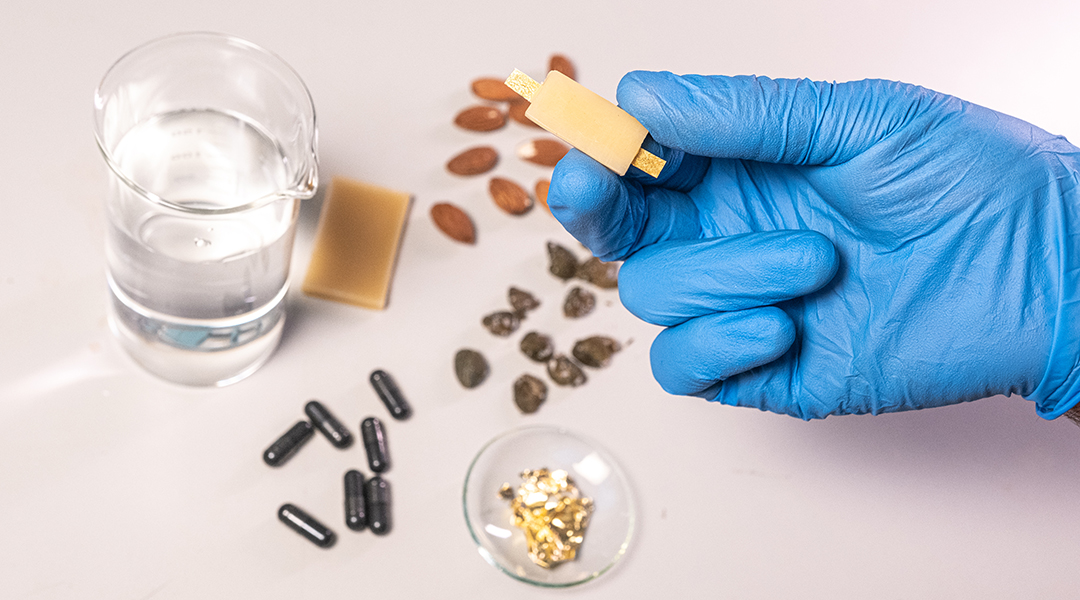Edible electronics are a growing field of technology that aims to develop devices made only from edible materials. If these devices can be fully realized, they could have major implications for the diagnosis and treatment of gastrointestinal tract diseases.
Not only could edible devices eventually replace invasive, painful, and expensive procedures, such as gastroscopy and endoscopy, but this consumable tech could also be used in food quality monitoring, reducing both the amount of food waste production and limiting cases of food poisoning.
One of the factors currently hindering the creation of edible technology is the problem of creating an edible power source. Thus far, attempts to do this have created edible supercapacitors that suffer from low energy per unit volume — a quantity called “energy density” — and a battery that leaves undesirable amounts of trace mineral manganese behind. While a little manganese is beneficial, too much can cause health effects like loss of appetite, slowed growth, and reproductive issues, significantly limiting how much of this battery that can be eaten.
Making a meal out a battery
A new paper published in the journal Advanced Materials documents the creation of a new edible battery that addresses these issues by being made exclusively from materials that can be eaten in large amounts.
“We demonstrated for the first time that a rechargeable battery can be realized by using only materials found in food,” said paper author and Istituto Italiano di Tecnologia, Center for Nano Science and Technology senior researcher, Mario Caironi. “In particular, we found a suitable edible material for every single component that is necessary to realize a working battery.”
Caironi explained that the proof-of-principle battery operates at 0.65 Volts (V), a safe voltage in case of ingestion, providing tens of microampere (μA) for more than 10 minutes, or a few μA for more than an hour. “Albeit limited in capacity, what we demonstrated is already enough to supply power to small electronic devices, such as low-power LEDs, for a limited time,” he added.
The battery can be used inside and outside of the human body and can even be recharged before it is swallowed.
Edible ingredients
Batteries work by converting stored chemical energy into electrical energy. This is done by passing electrons from one terminal electrode called the anode to another electrode called the cathode through an external circuit. To balance this, ions flow from the cathode to the anode via a substance in the battery called an electrolyte solution that is in contact with both electrodes.
The edible battery took the standard ingredients of a battery and recreated them with digestible substances, some of which are common foodstuffs.
The anode was created using vitamin B2, or riboflavin, found in beef, dairy, mushrooms, eggs, and cereals, while a supplement found in red onions and capers amongst other foods called quercetin was used as a cathode. The electrolyte was created from a water-based solution and activated charcoal, widely used in medicines and as black food coloring, was used to boost conductivity.
“The separator, needed in every battery to avoid short circuits, was made from nori seaweed, the kind found in sushi,” Caironi said. “Then, the electrodes were encapsulated in beeswax from which two food-grade gold contacts — the foil used by pastry chefs — on a cellulose-derived support extend.”
The materials used to create the edible battery are safe to consume in large amounts, with many food sources containing far larger concentrations than found in this power source for edible technology.
“For example, riboflavin and quercetin, active anode and cathode materials are common dietary supplements, which come in capsules with a couple of hundred milligrams, while our battery cells contain less than 0.5 milligrams of both,” said Ivan K. Ilic , the paper’s first author also from Istituto Italiano di Tecnologia. “The anode active material we used, riboflavin, is crucial in cell respiration. While quercetin, the cathode active material we used, does not perform such a role, similar molecules also participate in cell respiration.”
A surprise result
The researcher explained that even though the team combined the previous experience of its members who come from a wide range of interdisciplinary scientific fields, he was still somewhat surprised that the battery actually worked as well as it did.
“While we thought our battery will be able to work it was still shocking when it did actually work,” Ilic continued. “A lot of ingredients for our battery, active charcoal, gold foil, and sushi algae came from the supermarket and still, our battery was able to store energy as we planned it! Naturally, we were very happy.”
The team are currently hard at work in the lab developing a variety of different electronic elements, such as transistors, that will also be safely consumable.
“Once we crack the edible transistors, we will be able to build edible logic devices and power them with the battery,” Caironi concluded. “Then we will develop the first fully edible electronic devices with specific functions, such as monitoring of pH in the stomach and, eventually, more complex tasks.”
References: Mario Caironi, et al., An Edible Rechargeable Battery, Advanced Materials, (2023). DOI: 10.1002/adma.202211400
Feature image credit: G. Berretta Istituto Italiano di Tecnologia – © IIT, all rights reserved

















